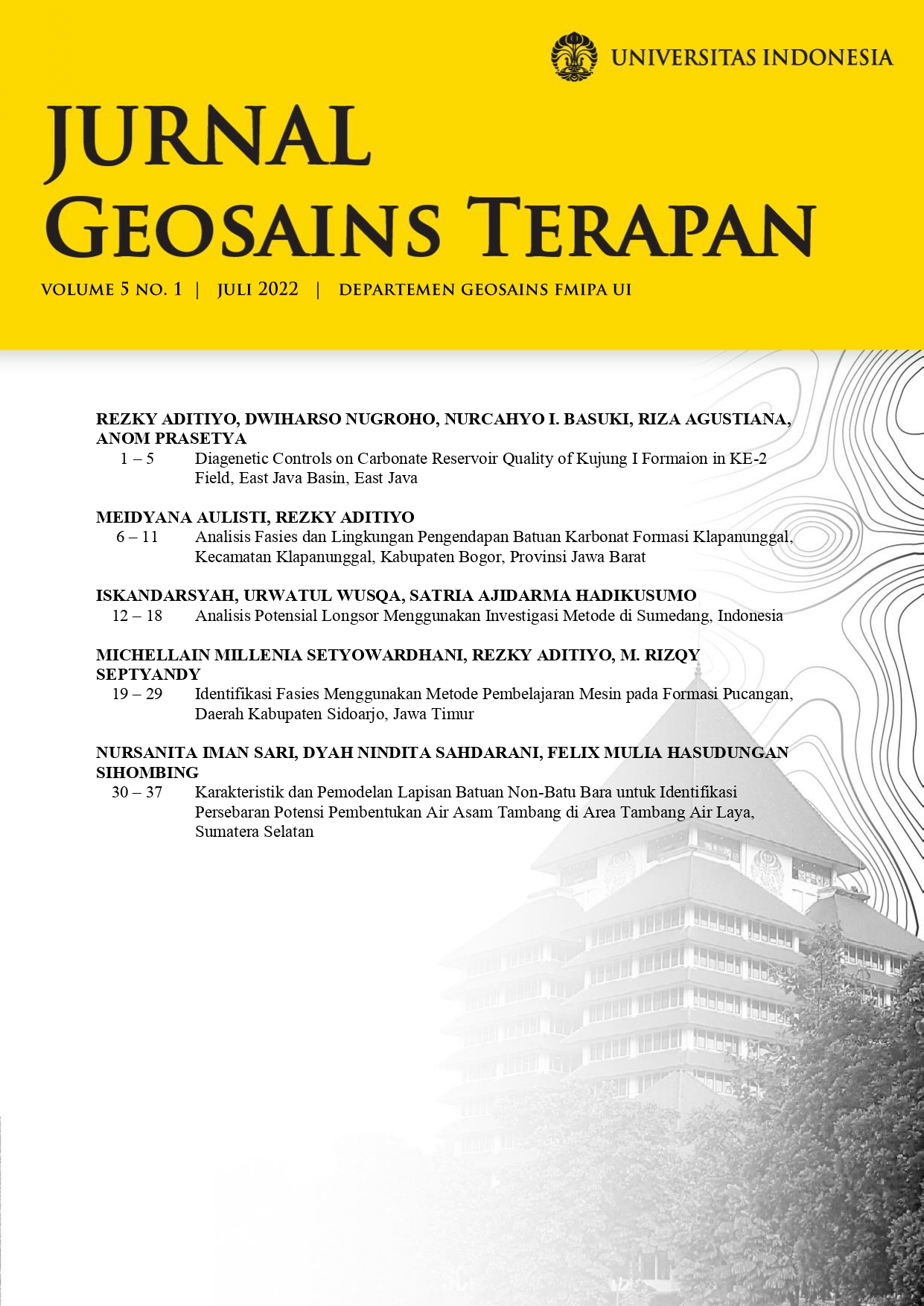Analisis Potensial Longsor Menggunakan Investigasi Metode di Sumedang, Indonesia
Kata Kunci:
Longsor, Cimanggung, GPR, Microcracking, Remote SensingAbstrak
Longsor yang terjadi pada beberapa bulan belakangan menjadi bencana yang serius di daerah Sumedang, Jawa Barat, Indonesia. Pada awal tahun 2021, terdapat kejadian longsor yang mengakibatkan 64 orang menjadi korban. Telah dilakukan beberapa penelitian oleh pemerintah untuk menentukan penyebab terjadinya longsor di lokasi tersebut. Tujuan dari penelitian ini adalah untuk mendeteksi lokasi lain di daerah ini yang memiliki potensi longsor. Pendekatan pertama yang dilakukan adalah pendekatan regional berdasarkan data satelit untuk mengklasifikasikan informasi potensi berdasarkan data kemiringan lahan dan tutupan lahan dari data remote sensing. Pendekatan kedua adalah pendekatan investigasi secara lokal menggunakan GPR yang merupakan metode elektromagnetik. Metode ini dapat mendeteksi keberadaan microcracking yang terdapat di bawah permukaan untuk mengevaluasi klasifikasi longsor dari data remote sensing. Berdasarkan analisis microcracking, dihasilkan daerah aman dari longsor dengan klasifikasi secara kualitatif dari potensi tinggi ke rendah.
Referensi
Benedetto, A., Benedetto, F., & Tosti, F. (2012). GPR applications for geotechnical stability of transportation infrastructures. Nondestructive Testing and Evaluation, 27(3), 253–262.
Bichler, A., Bobrowsky, P., Best, M., Douma, M., Hunter, J., Calvert, T., & Burns, R. (2004). Three-dimensional mapping of a landslide using a multi-geophysical approach: The Quesnel Forks landslide. Landslides, 1(1), 29–40.
Bobrowsky, P. T. (2013). Encyclopedia of natural hazards (Vol. 1135). Dordrecht: Springer.
Carey, J., Moore, R., Petley, D., Siddle, H., McInnes, R., Jakeways, J., Fairbank, H., & Mathie, E. (2007). Pre-failure behaviour of slope materials and their significance in the progressive failure of landslides. Landslides and Climate Change: Challenges and Solutions. Taylor & Francis Group: London, UK, 207–215.
Carey, J., & Petley, D. (2014). Progressive shear-surface development in cohesive materials; implications for landslide behaviour. Engineering Geology, 177, 54–65.
Cepeda, J., Smebye, H., Vangelsten, B., Nadim, F., & Muslim, D. (2010). Landslide risk in Indonesia. Glob. Assess. Rep. Disaster Risk Reduct, 20.
Crozier, M. J., & Glade, T. (2005). Landslide hazard and risk: Issues, concepts and approach. Landslide Hazard and Risk, 1–40.
Du, S., & Rummel, P. (1994). Reconnaisance studies of moisture in the subsurface with GPR. cp-300.
Glade, T., Anderson, M. G., & Crozier, M. J. (2006). Landslide hazard and risk. John Wiley & Sons.
Grote, K., Anger, C., Kelly, B., Hubbard, S., & Rubin, Y. (2010). Characterization of soil water content variability and soil texture using GPR groundwave techniques. Journal of Environmental & Engineering Geophysics, 15(3), 93–110.
Haniya, D. F. (2021). Upaya Pemerintah dalam Menangani Bencana Alam Tanah Longsor: Studi Kasus di Desa Cihanjuang Kecamatan Cimanggung Kabupaten Sumedang. Dialogue: Jurnal Ilmu Administrasi Publik, 3(1), 43–54.
Hu, Z., & Shan, W. (2016). Landslide investigations in the northwest section of the lesser Khingan range in China using combined HDR and GPR methods. Bulletin of Engineering Geology and the Environment, 75(2), 591–603.
Hungr, O., Leroueil, S., & Picarelli, L. (2014). The Varnes classification of landslide types, an update. Landslides, 11(2), 167–194.
Irawan, S., Aly, R., Syahputra, R., Kristyanto, T. H. W., & Tempesy, A. (2017). GPR application to investigate soil crack persistence in Cianjur landslide. 1861(1), 030042.
Lissak, C., Maquaire, O., Malet, J.-P., Lavigne, F., Virmoux, C., Gomez, C., & Davidson, R. (2015). Ground-penetrating radar observations for estimating the vertical displacement of rotational landslides. Natural Hazards and Earth System Sciences, 15(6), 1399–1406.
McColl, S. T. (2022). Landslide causes and triggers. In Landslide
Hazards, Risks, and Disasters (pp. 13–41). Elsevier.
Novellino, A., Cesarano, M., Cappelletti, P., Di Martire, D., Di Napoli, M., Ramondini, M., Sowter, A., & Calcaterra, D. (2021). Slow-moving landslide risk assessment combining Machine Learning and InSAR techniques. Catena, 203, 105317.
Pardeshi, S. D., Autade, S. E., & Pardeshi, S. S. (2013). Landslide hazard assessment: Recent trends and techniques. SpringerPlus, 2(1), 1–11.
Reynolds, J. M. (2011). An introduction to applied and environmental geophysics. John Wiley & Sons.
Rosi, A., Tofani, V., Tanteri, L., Tacconi Stefanelli, C., Agostini, A., Catani, F., & Casagli, N. (2018). The new landslide inventory of Tuscany (Italy) updated with PS-InSAR: geomorphological features and landslide distribution. Landslides, 15(1), 5–19.
Schuster, R. L., & Wieczorek, G. F. (2002). Landslide triggers and types. 59–78.
Sokolov, K., & Dyagileva, R. (2021). Possible of Using GPR and Electrical Tomography for Landslide Studies in The Quarry of Open Pits Mines in The Permafrost Zone. Conference Proceedings, Engineering and Mining Geophysics 2021, 1–8.
Spickermann, A., Malet, J.-P., van Asch, T. W., Van Maarseveen, M., Van Dam, D., & Markies, H. (2009). Analysis of soil failure modes and possible hydrological triggers using flume tests. EGU General Assembly 2009, 3784.
Sun, Q., Zhang, L., Ding, X., Hu, J., Li, Z., & Zhu, J. (2015). Slope deformation prior to Zhouqu, China landslide from InSAR
time series analysis. Remote Sensing of Environment, 156, 45–57.
Tomás, R., Li, Z., Lopez-Sanchez, J. M., Liu, P., & Singleton, A. (2016). Using wavelet tools to analyse seasonal variations from InSAR time-series data: A case study of the Huangtupo landslide. Landslides, 13(3), 437–450.
Topp, G. C., Davis, J., & Annan, A. P. (1980). Electromagnetic determination of soil water content: Measurements in coaxial transmission lines. Water Resources Research, 16(3), 574–582.
Turner, A. K., & Jayaprakash, G. (1996). Landslides: Investigation and mitigation. Chapter 1-introduction (Issue 247).
Van Bemmelen, R. (1949). The Geology of Indonesia: General Geology of Indonesia and adjacent archipelagoes. Nijhoff: The Hague Gov. Print. Off.
Varnes, D. (1981). The principles and practice of landslide hazard zonation. Bulletin of the International Association of Engineering Geology-Bulletin de l’Association Internationale de Géologie de l’Ingénieur, 23(1), 13–14.
Varnes, D. J. (1978). Slope movement types and processes. Special Report, 176, 11–33.
Wieczorek, G. F. (1996). Landslides: Investigation and mitigation. Chapter 4: Landslide triggering mechanisms. Transportation Research Board Special Report, 247.
Zhang, Y., Meng, X., Dijkstra, T., Jordan, C., Chen, G., Zeng, R., & Novellino, A. (2020). Forecasting the magnitude of potential landslides based on InSAR techniques. Remote Sensing of Environment, 241, 111738
Diterbitkan
Cara Mengutip
Lisensi
Hak Cipta (c) 2022 Jurnal Geosains Terapan

Artikel ini berlisensi Creative Commons Attribution-NonCommercial-NoDerivatives 4.0 International License.


